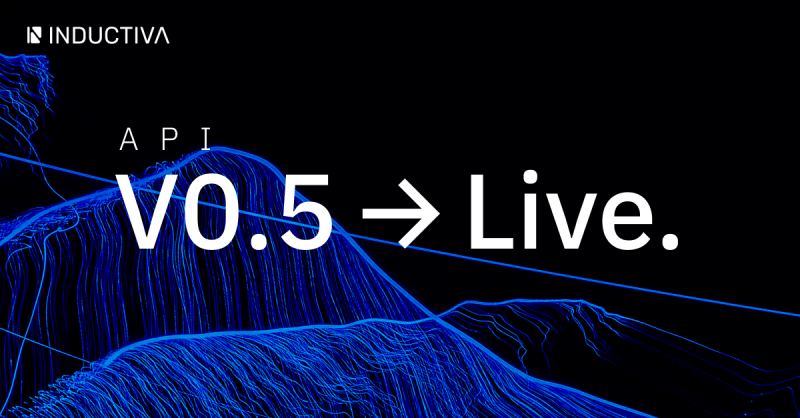Generating Synthetic Data for Physics-ML with Inductiva API V - Test the Impact of Hyperparameter Changes




Quick Recap
In the preceding step of our tutorial, we used Inductiva’s Templating Engine. to generalize the physical properties and initial conditions of the fluid block in our “base case” simulation. By substituting certain values in our configuration file with placeholders, we enabled the template to incorporate assigned values, enabling programmable adjustments of each variable via our Python script.
Now, we will move on to the hyperparameters of our simulation, which are important due to their influence on both the fidelity of the simulation and the associated computational requirements and costs. Among various hyperparameters, we will specifically focus on adjusting the particle radius value and how it affects computational costs and data output. To illustrate this, we will run four simulations with decreasing particle radii while keeping the remaining parameters fixed to understand these impacts better.
Generalizing the Particle Radius
Using the same methodology from our previous step, we will substitute the categorical
and numerical value of the particle radius hyperparameter in the .JSON configuration
file we previously downloaded with a templated variable:
{{ variable_name }}
Here’s what our templated configuration file looks like, where we’ve kept all hyperparameters fixed except for the particle radius:
"Configuration": {
"stopAt": 1,
"timeStepSize": 0.001,
"particleRadius": {{ particle_radius | default(0.008) }},
"simulationMethod": 4,
"boundaryHandlingMethod": 0,
"kernel": 1,
"cflMethod": 1,
"cflFactor": 0.5,
"cflMinTimeStepSize": 0.0001,
"cflMaxTimeStepSize": 0.005,
"gravitation": [0, 0, -9.81],
"gradKernel": 1,
"enableVTKExport": true,
"dataExportFPS": 60,
"particleAttributes": "velocity;density"
}
Now, let’s save the .JSON file in the local directory, within the download folder,
to prepare for running the simulation.
Running the Templated Simulation
After updating our configuration file, we’re ready to run simulations with different
particle sizes. We will invoke the below Python script to set up a group of machines
for the simulations and initialize our templating engine to easily fill in the
particle size variable values. We’re testing four sizes: 0.01, 0.008, 0.006, and 0.004 meters.
import inductiva
# Launch a machine group with a c3-standard-4
machine_group = inductiva.resources.MachineGroup("c3-standard-4")
machine_group.start()
# Assuming the template folder was downloaded to the local directory,
# set the path to it.
template_dir = "./splishsplash-template-dir"
# Define the radii of the particles
particle_radii = [0.01, 0.008, 0.006, 0.004]
tasks_list = []
# Initialize the templating engine
template_manager = inductiva.TemplateManager(template_dir)
for n, radius in enumerate(particle_radii, start=1):
# set the output directory to a different folder for each simulation
# and render the entire content of the template directory with the
# particle radius set to the current value
template_manager.set_root_dir("splishsplash-hyperparameter-search_%d" % n)
template_manager.render_dir(particle_radius=radius)
task = SPlisHSPlasH.run(input_dir=template_manager.get_root_dir(),
sim_config_filename="config.json",
on=machine_group)
tasks_list.append(task)
For each particle size, our API creates a new folder, updates the settings with the new size, and starts the simulation. This lets us run all four simulations at the same time, making it faster to see how changing the particle size affects the results.
Instead of waiting for each simulation to complete within the running script, we can track their progress and collect the results afterwards using our Command Line Interface (CLI):
# Monitor the status of the tasks every 10 seconds
$ inductiva task list -n 4 --watch 10
# Download the results of the tasks
$ inductiva storage list -m 4
Impact of Particle Radius on Simulation Volume and Data Output
The table below shows how the different particle radius values we’ve chosen affect the total number of particles and the amount of data generated. As we decrease the particle radius, we need more particles for the simulation, increasing the data volume. Specifically, halving the particle radius results in an eightfold increase in the number of particles and the data produced, due to the volume scaling with the cube of the particle radius (\(r_{particle}{^3}\)).
Table 1. Number of particles and total size of simulation output for each particle radius.
| Particle Radius | Total N. of Particles | Size of data produced |
|---|---|---|
| 0.01 | 15625 | 166 MB |
| 0.008 | 29791 | 213 MB |
| 0.006 | 73720 | 525 MB |
| 0.004 | 244584 | 1.76 GB |
Performance and Cost Analysis Across Machine Configurations
Reducing the particle radius naturally results in a higher number of particles required for the simulation to run, and this demands more computing power. While upgrading to more powerful machines can reduce computational times, it also incurs significantly higher costs. To better understand these factors, we’ve run our simulations across various machine configurations. The resulting data, shown in the tables below, outlines runtime and costs for our four simulations on three different machine types:
c3-standard-4at $0.23 per hourc3-standard-8at $0.459 per hourc3-standard-88at $5.053 per hour
Table 2.
Simulation runtimes and costs on a c3-standard-4 machine, priced at $0.23 per
hour, as performed via the Inductiva API.
| Particle Radius | Time to run | Cost in $ |
|---|---|---|
| 0.01 | 16m31s | 0.06 |
| 0.008 | 27m11s | 0.10 |
| 0.006 | 56m59s | 0.22 |
| 0.004 | 6h11m27s | 1.42 |
Table 3.
Simulation runtimes and costs on a c3-standard-8 machine, priced at $0.459 per
hour, as performed via the Inductiva API.
| Particle Radius | Time to run | Cost in $ |
|---|---|---|
| 0.01 | 9m38s | 0.07 |
| 0.008 | 15m11s | 0.12 |
| 0.006 | 35m34s | 0.27 |
| 0.004 | 3h28m31s | 1.60 |
Table 4.
Simulation runtimes and costs on a c3-standard-88 machine, priced at $5.053 per
hour, as performed via the Inductiva API.
| Particle Radius | Time to run | Cost in $ |
|---|---|---|
| 0.01 | 3m27s | 0.29 |
| 0.008 | 5m16s | 0.44 |
| 0.006 | 8m20s | 0.70 |
| 0.004 | 1h25m04s | 7.16 |
Notice that choosing more powerful hardware does not correspondingly decrease computational times as much as it increases costs. Upgrading the virtual CPUs from 8 to 88 doesn’t proportionally reduce computational time 11-fold. On average, run times typically drop by only about a factor of 3, while costs soar by 5 times.
Up Next: Benchmarking Computational Resources
In this step, we assessed how adjusting hyperparameters, particularly the particle radius,
impacts the computational times and costs of our “base case” simulation. We ran
four simulations with increasingly smaller particle radii while keeping all other
parameters fixed. This change naturally increased the number of particles needed
to run the simulation and the amount of data it produced, which in turn demanded
more computing power. Following this, we looked into how these changes influenced
the cost and duration of computing by running the simulation across different
hardware configurations.
Performing such benchmarks becomes crucial for understanding the necessary trade-offs in synthetic data generation, especially considering the potential to scale up to 10,000 simulations in a manner that is both time-efficient and cost-effective. If we revisit the study we built upon for this tutorial, a higher particle count results in a larger graph, potentially complicating memory requirements for training graph neural networks (GNNs). In our next chapter, we’ll dive deeper into the computational costs and runtimes for such large scale-ups and learn how to efficiently benchmark computational resources.
Recent posts from our blog

Luís Sarmento

Ivan Pombo

Maya Hershey
Discover the 3D model mesh resolution threshold that still yields stable and dependable estimations of physical properties in engineering simulations.

Hugo Penedones

Luís Sarmento
The Inductiva API v0.5 release brings two New Simulators, Up-to-date GCP pricing information, additional features on Command Line Interface, more Metrics and Benchmarks, a Template Manager and more revamped Documentation. Additionally we are open sourcing all the scientific software containers we are using in our backend - Project KUTU.

